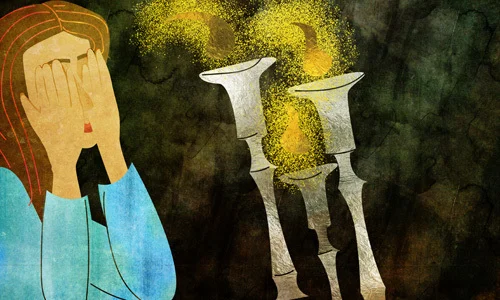Our Dangerously Insane President
Dear Editor:
Just a few, short words on the current mental state of our leader. Sad to say, but necessary to understand: President Biden is insane. Anyone with a clear sense of unbiased judgment can easily determine the signs of human deterioration by just viewing his walking, body rigidity, vacant, blank, unblinking stare, confusion and listening to his muted, mutilated, mumbled and incoherent speech. Not a decision made based on political enmity or personal dislike of the man. Just stating reality.
And throwing into this pile, the fact that he is the most powerful person in today’s world, more people should show their unbiased concern for the danger in which he places us, our nation and the planet. But only a brave few are bringing the subject up. Why are not those caring, friendly, world leaders who visit with, sit down beside him, confer with him and frighteningly, make decisions together with him, speak up and tell us of his condition?
Most recently, when hosting the president of Kenya at the White House, Biden had to ask a reporter to repeat her long question to him. He then shamelessly responded by actually rapidly reading a complicated, well rehearsed answer to the obviously (by his staff) prepared question. Without his notes he is a goner in front of the camera. One only wonders how the leaders of our enemies, China and Russia, view him when they confer with him at their private meetings. Scary scenario for all of us under his protective wing. And if you’re a Democrat, you should lose sleep worrying how he will handle Trump during the planned debates. As well, if you’re a betting person, please call me to wager if he will make it to the first one. Name your amount.
Sincerely
Alan Bergstein
Boca Raton, Fla
Experts Weigh in On ICC’s Arrest Warrants
Dear Editor:
Surely by now we are all convinced the United Nations and its myriad agencies are corrupt and destructive.
The latest outrage is the International Criminal Court bringing charges against both Israel and Hamas. By what perverted logic has the ICC equated Israel, a thriving liberal democracy with a robust judiciary, the 10th most powerful country in the world and the 6th happiest, with Hamas, an internationally recognized terrorist entity which has brutally occupied Gaza since killing and driving out its PA opponents in 2006.
As a sop to fairness, Karim A.A. Khan, chief prosecutor of the court issued arrest warrants for PM Benjamin Netanyahu, MK Yaov Gallant and three top Hamas leaders.
Where are the warrants for Iranian and Hezbollah leaders and military commanders who planned and directed the October 7, 2023 bloody massacre of innocent Israeli civilians?
Where is the warrant for PA chairman Mahmoud Abbas, whose government pays Palestinian terrorists and their families for murdering Jews?
The UN has 193 members; 56 are Islamic and one is Jewish. Only 33 states are true democracies. The dictatorships use their majority to bully and to suck money out of the 33 free nations.
The 33 generate wealth because they respect the individual and his ability to succeed or fail as talent and circumstances allow. The autocracies, some blessed with oil, govern by force; wealth flows to the few in power. Abbas, for example, lives in a $30,000,000 home on Palace Row in Ramallah. Hamas’s Mohammed Al-Masri and Ismail Haniya are billionaires who divide their time between Turkey and the beaches of Doha in Qatar.
The UN is dominated by three blocks: the Russians, the Chinese and the Islamic states.
The Russians, whose Soviet KGB created the PLO and the Palestinian people in 1964, have a dedicated following.
China, with its vast economic ties around the globe, is the up-and-coming dominant super-power.
The Islamist states dream of replacing the Infidels with a Caliphate. To this end they are flooding the 33 with immigrants who have no intention of adapting to their new homes and who work tirelessly to dominate academia and indoctrinate our soft, pliable, immature youth. Islamists will quicky dominate institutions at the local level.
The crowning glory of the UN is UNRWA, the fraud that provides cover for Hamas, Islamic Jihad and others. They perform Gaza’s municipal services, freeing up the terrorists to be terrorists.
They run all Palestinian ‘refugee’ schools, teaching children that killing Jews and wiping Israel off the map is their highest calling.
It is UNWRA who rejects the 2-state solution touted by the West and offered by Israel several times since 1947. UNRWA demands, “From the river to the sea, Palestine will be free”. It means, free of Jews.
UNRWA has transformed from a temporary organization, tasked with finding new homes for the 700,000 Arabs who fled during the 1948 war, into a 30,000-man conglomerate which considers everyone in the world, rich or poor, who had a relative who once lived in the British Mandate for Palestine, to be a refugee. Even those living in Israel, who never moved are considered refugees.
So long as Israel exists, these 5,000,000 so-called refugees will still be refugees.
The rest of us have been conned into going along with this madness.
The 20th century saw millions of refugees. They were resettled and got on with their lives. Only the Palestinians are treated as perennial beggars.
Is the problem the United Nations or the 33 democracies who fund it?
Sincerely
Len Bennett, Author of ‘Unfinished Work’
Deerfield Beach, Fl
Stop Brainwashing Our Kids!
Dear Editor,
I agree with the reader who said that parents should stop sending their children to the major American universities, and send them to Jewish-majority colleges, whether in the U.S. or Israel. Even if these crazy protests subside, America’s colleges are filled with faculty members who teach anti-Israel hatred. We don’t need them brainwashing our kids!
Sincerely
Menachem Cohen
Boro Park
Jewish Orgs Should Take On Blinken
Dear Editor:
Here’s an idea for one of our Zionist organizations to undertake. They should count how many times Secretary of State Blinken has complained about Israel accidentally killing civilians, and then count how many times he has criticized Hamas for using those civilians as human shields. I think we can all predict the results of such a tally, but we need to know the exact numbers. One of our many pro-Israel organizations, with their big staffs and plentiful resources, should be able to do that without too much trouble.
Sincerely
Larry Berman
Flatbush
Saudi Arabia in Not a “Moderate” Arab Country
Dear Editor:
Thanks for your May 28 article about the Saudis once again trying to bully Israel into accepting a Palestinian state. I think it’s about time we all discarded this idea that Saudi Arabia is “moderate,” once and for all. They’re just as extreme and anti-Israel as all the rest of the Arab regimes; they just sometimes tone down the rhetoric a bit for the sake of some temporary diplomatic advantage. But at the end of the day, they are fanatical Muslims who pursue a fanatical Muslim agenda that has no room for a permanent Jewish state, anywhere.
Sincerely
Amanda Norkelheim
Brooklyn

























